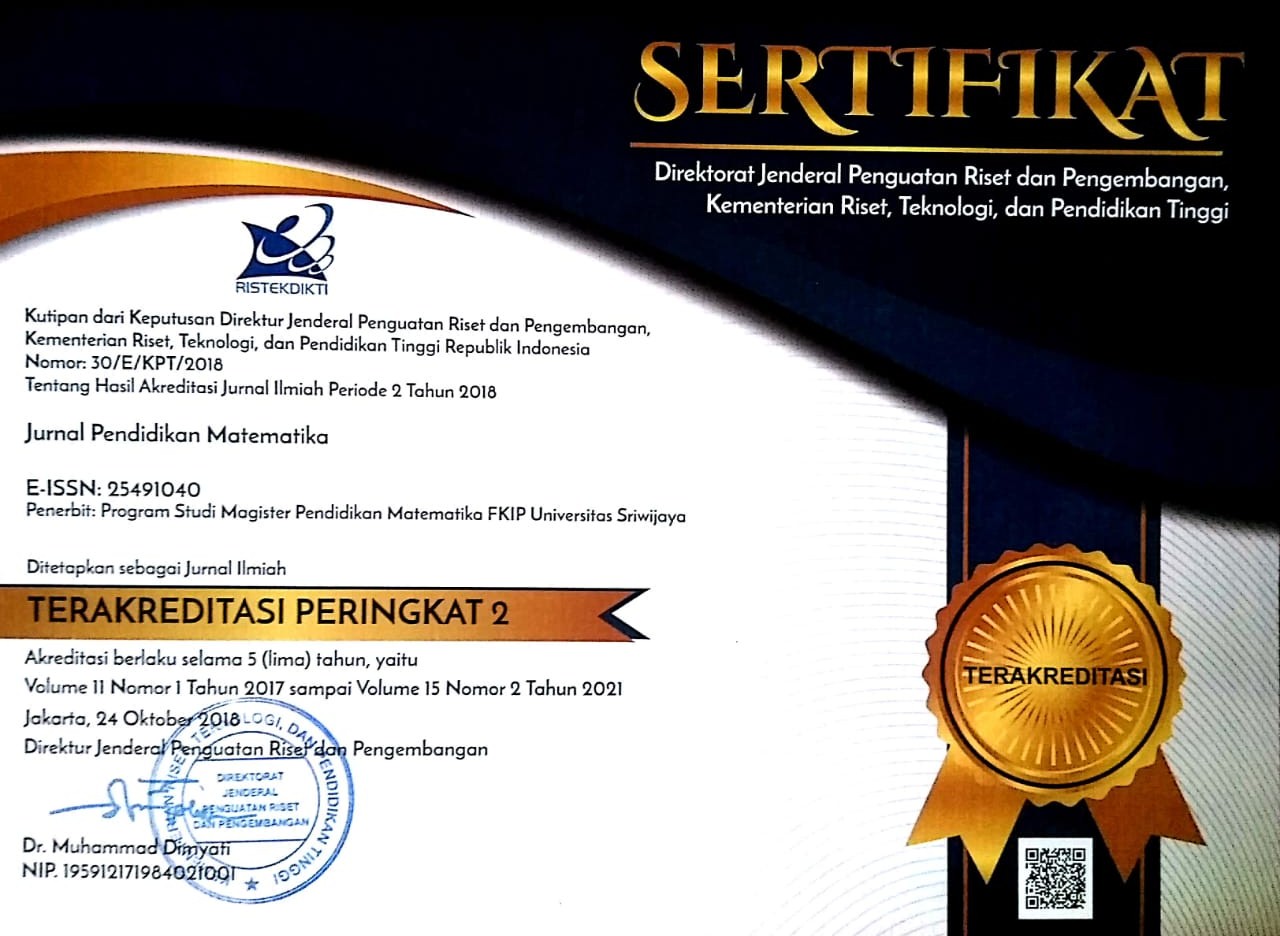How to Learning Arithmetic Sequences with Project-Based Learning in Terrace Culture?
Abstract
Keywords
Full Text:
PDFReferences
Ambrosio, U. D. (1985). Ethnomathematics and its place in the history and pedagogy of mathematics. For the Learning of Mathematics, 5(1), 44–48. https://doi.org/10.1007/978-3-319-59220-6_12 .
D’Ambrosio, U. (2016). An overview of the history of ethnomathematics. 5–10. https://doi.org/10.1007/978-3-319-30120-4_2
Dewi, I. N., Poedjiastoeti, S., & Prahani, B. K. (2017). ElSII learning model based local wisdom to improve students’ problem solving skills and scientific communication. International Journal of Education and Research, 5(1), 107–118. https://doi.org/10.1088/1742-6596/1157/2/022014 .
Haryadi, D., Mawardi, M., & Razali, M. R. (2019). Terracing slope analysis in landslide management efforts fellenius method with geostudio slope program. Inersia, Jurnal Teknik Sipil, 10(2), 53–60. https://doi.org/10.33369/ijts.10.2.53-60
Imswatama, A., & Lukman, H. S. (2018). The effectiveness of mathematics teaching material based on ethnomathematics. International Journal of Trends in Mathematics Education Research, 1(1), 35. https://doi.org/10.33122/ijtmer.v1i1.11
Kizos, T., Dalaka, A., & Petanidou, T. (2010). Farmers’ attitudes and landscape change: Evidence from the abandonment of terraced cultivations on Lesvos, Greece. Agriculture and Human Values, 27(2), 199–212. https://doi.org/10.1007/s10460-009-9206-9
Levis, L. R. (2013). Farmer behavior research methods. Maumure: Ledalero.
Maretya, D. A. (2017). Farmers' behavior in managing terraced land in Sukasari Kaler Village, Argapura District, Majalengka Regency. Jurnal Bumi Indonesia, 6, 4.
Muhtadi, D., Sukirwan, Warsito, & Prahmana, R. C. I. (2017). Sundanese ethnomathematics: Mathematical activities in estimating, measuring, and making patterns. Journal on Mathematics Education, 8(2), 185–198. https://doi.org/10.22342/jme.8.2.4055.185-198
Mungmachon, M. R. (2012). Knowledge and local wisdom : Community treasure. International Journal of Humanities and Social Science, 2(13), 174–181.
Prahmana, R. C. I., Zulkardi, & Hartono, Y. (2012). Learning multiplication using indonesian traditional game in third grade. Journal on Mathematics Education, 3(2), 115–132. https://doi.org/10.22342/jme.3.2.1931.115-132.
Pratiwi, E. R., & Sudrajat. (2012). Farmers' behavior in managing agricultural land in landslide prone areas (Case study of Sumberejo Village, Batur District, Banjarnegara Regency, Central Java). Jurnal Bumi Indonesia, 1(3), 355–362.
Rakhmawati, R. (2016). Cultural-based mathematics activities in Lampung society. Al-Jabar : Jurnal Pendidikan Matematika, 7(2), 221–230. https://doi.org/10.24042/ajpm.v7i2.37
Risdiyanti, I., & Prahmana, R. C. I. (2020). The learning trajectory of number pattern learning using barathayudha war stories and uno stacko. Journal on Mathematics Education, 11(1), 157–166. https://doi.org/10.22342/jme.11.1.10225.157-166
Rohaeti, E. E. (2011). Cultural transformation through meaningful mathematics learning in schools. Jurnal Pengajaran Matematika Dan Ilmu Pengetahuan Alam, 16(1), 139. https://doi.org/10.18269/jpmipa.v16i1.274
Sasana, H. (2017). Working time allocation of rice farmer households with Batak Toba tradition at Toba Samosir North Sumatera. International Journal of Economic Research (IJER), 8(3), 50–58.
Sukartaatmadja. (2004). Soil and water conservation. Bogor: IPB Press.
Sumiyanto, S., & Patria, A. N. (2010). Effect of terracing on slopes on landslide potential. Jurnal Ilmiah Dinamika Rekayasa, 6(2), 50–55.
Tanujaya, B., Prahmana, R. C. I., & Mumu, J. (2017). Mathematics instruction, problems, challenges, and opportunities: A case study in Manokwari Regency, Indonesia. World Transactions on Engineering and Technology Education, 15(3), 287–291.
Wagiran. (2011). Development of local wisdom education models in supporting the development vision of the special region of Yogyakarta 2020 (Second year). Jurnal Penelitian Dan Pengembangan N, 3(5), 1–29.
DOI: https://doi.org/10.22342/jpm.15.2.13800.133-144
Jl. Srijaya Negara, Bukit Besar
Palembang - 30139 Indonesia
Jurnal Pendidikan Matematika is licensed under a Creative Commons Attribution-NonCommercial-ShareAlike 4.0 International License.
Indexed in:


